Long-Term Stability of Low-Pressure Reverse Osmosis (RO) Membrane Operation—A Pilot Scale Study
Abstract
1. Introduction
2. Materials and Methods
2.1. Scheme of the Long-Term Pilot Test
2.2. Monitoring Parameters in the Pilot Test
Qo × ((Pi − ΔPi/2 − Ppi − πi) × TCFi)/((Po − ΔPo/2 − Ppo − πo) × TCFo)
(Cpo × NDPo × TCFi × Cfci × Cfo)/(Cfco × NDPi × TCFo × Cfco × Cfi)
2.3. Laboratory Fouling Susceptibility Test
2.4. Membrane Analysis
3. Results and Discussion
3.1. Laboratory Fouling Susceptibility Test and Pristine Membrane Analysis
3.2. Operating-Pressure Variations According to the Permeate Flow Rate of the RO Elements
3.3. Variations of the Normalized Permeate Flow Rate (NPF) and Normalized Salt Passage (NSP) According to the Permeate Flow Rate of the RO Elements
3.4. Estimation of Individual Element Performances
3.5. Membrane and Foulant Analysis
3.6. LPRO Feasibility Estimation Study Based on the Pilot Test Results
4. Conclusions
Acknowledgments
Author Contributions
Conflicts of Interest
References
- Cadotte, J.E.; King, R.S.; Majerle, R.J.; Petersen, R.J. Interfacial synthesis in the preparation of reverse osmosis membranes. J. Macromol. Sci. Chem. 1981, A15, 727–755. [Google Scholar] [CrossRef]
- Kesting, R.E. Synthetic Polymeric Membranes; Mcgraw-Hill Book Company: New York, NY, USA; St. Louis, MO, USA; San Francisco, CA, USA, 1971. [Google Scholar]
- Roh, I.J. Influence of rupture strength of interfacially polymerized thin-film structure on the performance of polyamide composite membranes. J. Membr. Sci. 2002, 198, 63–74. [Google Scholar] [CrossRef]
- Karode, S.K.; Kulkarni, S.S.; Suresh, A.K.; Mashelkar, R.A. New insights into kinetics and thermodynamics of interfacial polymerization. Chem. Eng. Sci. 1998, 53, 2649–2663. [Google Scholar] [CrossRef]
- Son, M.; Park, H.; Liu, L.; Choi, H.; Kim, J.H.; Choi, H. Thin-film nanocomposite membrane with CNT positioning in support layer for energy harvesting from saline water. Chem. Eng. J. 2016, 284, 68–77. [Google Scholar] [CrossRef]
- Venkata Swamy, B.; Madhumala, M.; Prakasham, R.S.; Sridhar, S. Nanofiltration of bulk drug industrial effluent using indigenously developed functionalized polyamide membrane. Chem. Eng. J. 2013, 233, 193–200. [Google Scholar] [CrossRef]
- Byrne, W. Reverse Osmosis, 2nd ed.; Tall Oaks Publishing Inc.: Littleton, CO, USA, 1995. [Google Scholar]
- Kucera, J. Reverse Osmosis; John Wiley & Sons: Hoboken, NJ, USA, 2010. [Google Scholar]
- Mulder, M. Basic Principles of Membrane Technology, 2nd ed.; Kluwer Academic Publishers: Dordrecht, The Netherlands, 1996. [Google Scholar]
- Kwon, Y.-N.; Hong, S.; Choi, H.; Tak, T. Surface modification of a polyamide reverse osmosis membrane for chlorine resistance improvement. J. Membr. Sci. 2012, 415–416, 192–198. [Google Scholar] [CrossRef]
- Hasson, D.; Shemer, H.; Brook, I.; Zaslavschi, I.; Semiat, R.; Bartels, C.; Wilf, M. Scaling propensity of seawater in RO boron removal processes. J. Membr. Sci. 2011, 384, 198–204. [Google Scholar] [CrossRef]
- Ghosh, A.K.; Hoek, E.M.V. Impacts of support membrane structure and chemistry on polyamide–polysulfone interfacial composite membranes. J. Membr. Sci. 2009, 336, 140–148. [Google Scholar] [CrossRef]
- Gu, J.E.; Jun, B.M.; Kwon, Y.N. Effect of chlorination condition and permeability of chlorine species on the chlorination of a polyamide membrane. Water Res. 2012, 46, 5389–5400. [Google Scholar] [CrossRef] [PubMed]
- Choi, H.; Park, J.; Tak, T.; Kwon, Y.-N. Surface modification of seawater reverse osmosis (SWRO) membrane using methyl methacrylate-hydroxy poly(oxyethylene) methacrylate (MMA-HPOEM) comb-polymer and its performance. Desalination 2012, 291, 1–7. [Google Scholar] [CrossRef]
- Hong, S.; Kim, I.-C.; Tak, T.; Kwon, Y.-N. Interfacially synthesized chlorine-resistant polyimide thin film composite (TFC) reverse osmosis (RO) membranes. Desalination 2013, 309, 18–26. [Google Scholar] [CrossRef]
- Kwon, Y.-N.; Joksimovic, R.; Kim, I.-C.; Leckie, J.O. Effect of bromide on the chlorination of a polyamide membrane. Desalination 2011, 280, 80–86. [Google Scholar] [CrossRef]
- Xia, S.; Yao, L.; Zhao, Y.; Li, N.; Zheng, Y. Preparation of graphene oxide modified polyamide thin film composite membranes with improved hydrophilicity for natural organic matter removal. Chem. Eng. J. 2015, 280, 720–727. [Google Scholar] [CrossRef]
- Park, H.-G.; Cho, S.-G.; Kim, K.-J.; Kwon, Y.-N. Effect of feed spacer thickness on the fouling behavior in reverse osmosis process—A pilot scale study. Desalination 2016, 379, 155–163. [Google Scholar] [CrossRef]
- Li, N.N.; Fane, A.G.; Winston, W.S.; Matsuura, T. Advanced Membrane Technology and Applications; John Wiley & Sons, Inc.: Hoboken, NJ, USA, 2008. [Google Scholar]
- Huang, H.; Schwab, K.; Jacangelo, J.G. Pretreatment for low pressure membranes in water treatment: A review. Environ. Sci. Technol. 2009, 43, 3011–3019. [Google Scholar] [CrossRef] [PubMed]
- Baker, R.W. Membrane Technology and Applications, 2nd ed.; John Wiley & Sons: Chichester, UK, 2004. [Google Scholar]
- Dalvi, A.G.I.; Al-Rasheed, R.; Javeed, M.A. Studies on organic foulants in the seawater feed of reverse osmosis plants of SWCC. Desalination 2000, 132, 217–232. [Google Scholar] [CrossRef]
- Kucera, J. Reverse Osmosis: Design, Processes, and Applications for Engineers, 2nd ed.; Scrivener Publishing, Wiley: Hoboken, NJ, USA, 2015. [Google Scholar]
- Araújo, P.A.; Kruithof, J.C.; Van Loosdrecht, M.C.M.; Vrouwenvelder, J.S. The potential of standard and modified feed spacers for biofouling control. J. Membr. Sci. 2012, 403–404, 58–70. [Google Scholar] [CrossRef]
- She, Q.; Wang, R.; Fane, A.G.; Tang, C.Y. Membrane fouling in osmotically driven membrane processes: A review. J. Membr. Sci. 2016, 499, 201–233. [Google Scholar] [CrossRef]
- Wang, Y.-N.; Tang, C.Y. Protein fouling of nanofiltration, reverse osmosis, and ultrafiltration membranes—The role of hydrodynamic conditions, solution chemistry, and membrane properties. J. Membr. Sci. 2011, 376, 275–282. [Google Scholar] [CrossRef]
- Choi, H.; Jung, Y.; Han, S.; Tak, T.; Kwon, Y.-N. Surface modification of SWRO membranes using hydroxyl poly(oxyethylene) methacrylate and zwitterionic carboxylated polyethyleneimine. J. Membr. Sci. 2015, 486, 97–105. [Google Scholar] [CrossRef]
- Kwon, Y.-N.; Shih, K.; Tang, C.; Leckie, J.O. Adsorption of perfluorinated compounds on thin-film composite polyamide membranes. J. Appl. Polym. Sci. 2012, 124, 1042–1049. [Google Scholar] [CrossRef]
- Bacchin, P.; Aimar, P.; Field, R.W. Critical and sustainable fluxes: Theory, experiments and applications. J. Membr. Sci. 2006, 281, 42–69. [Google Scholar] [CrossRef]
- Drews, A. Membrane fouling in membrane bioreactors—Characterisation, contradictions, cause and cures. J. Membr. Sci. 2010, 363, 1–28. [Google Scholar] [CrossRef]
- Le-Clech, P.; Chen, V.; Fane, T.A.G. Fouling in membrane bioreactors used in wastewater treatment. J. Membr. Sci. 2006, 284, 17–53. [Google Scholar] [CrossRef]
- Tang, C.Y.; Chong, T.H.; Fane, A.G. Colloidal interactions and fouling of NF and RO membranes: A review. Adv. Colloid Interface Sci. 2011, 164, 126–143. [Google Scholar] [CrossRef] [PubMed]
- Norberg, D.; Hong, S.; Taylor, J.; Zhao, Y. Surface characterization and performance evaluation of commercial fouling resistant low-pressure RO membranes. Desalination 2007, 202, 45–52. [Google Scholar] [CrossRef]
- Zhao, L.; Chang, P.C.Y.; Yen, C.; Ho, W.S.W. High-flux and fouling-resistant membranes for brackish water desalination. J. Membr. Sci. 2013, 425–426, 1–10. [Google Scholar] [CrossRef]
- Louie, J.S.; Pinnau, I.; Ciobanu, I.; Ishida, K.P.; Ng, A.; Reinhard, M. Effects of polyether–polyamide block copolymer coating on performance and fouling of reverse osmosis membranes. J. Membr. Sci. 2006, 280, 762–770. [Google Scholar] [CrossRef]
- Gilron, J.; Belfer, S.; Väisänen, P.; Nyström, M. Effects of surface modification on antifouling and performance properties of reverse osmosis membranes. Desalination 2001, 140, 167–179. [Google Scholar] [CrossRef]
- Belfer, S.; Purinson, Y.; Fainshtein, R.; Radchenko, Y.; Kedem, O. Surface modification of commercial composite polyamide reverse osmosis membranes. J. Membr. Sci. 1998, 139, 175–181. [Google Scholar] [CrossRef]
- Freger, V.; Gilron, J.; Belfer, S. TFC polyamide membranes modified by grafting of hydrophilic polymers: An FT-IR/AFM/TEM study. J. Membr. Sci. 2002, 209, 283–292. [Google Scholar] [CrossRef]
- Toray Chemical Korea Inc. CSM Technical Manual; Toray Chemical Korea Inc.: Seoul, Korea, 2008. [Google Scholar]
- Xie, M.; Nghiem, L.D.; Price, W.E.; Elimelech, M. Impact of organic and colloidal fouling on trace organic contaminant rejection by forward osmosis: Role of initial permeate flux. Desalination 2014, 336, 146–152. [Google Scholar] [CrossRef]
- Miller, D.J.; Kasemset, S.; Paul, D.R.; Freeman, B.D. Comparison of membrane fouling at constant flux and constant transmembrane pressure conditions. J. Membr. Sci. 2014, 454, 505–515. [Google Scholar] [CrossRef]
- Tang, C.Y.; Kwon, Y.-N.; Leckie, J.O. The role of foulant–foulant electrostatic interaction on limiting flux for RO and NF membranes during humic acid fouling—Theoretical basis, experimental evidence, and AFM interaction force measurement. J. Membr. Sci. 2009, 326, 526–532. [Google Scholar] [CrossRef]
- Kwon, Y.-N.; Leckie, J.O. Hypochlorite degradation of crosslinked polyamide membranes: I. Changes in chemical/morphological properties. J. Membr. Sci. 2006, 283, 21–26. [Google Scholar] [CrossRef]
- Kwon, Y.-N.; Leckie, J.O. Hypochlorite degradation of crosslinked polyamide membranes: II. Changes in hydrogen bonding behavior and performance. J. Membr. Sci. 2006, 282, 456–464. [Google Scholar] [CrossRef]
- Chun, Y.; Zaviska, F.; Kim, S.-J.; Mulcahy, D.; Yang, E.; Kim, I.S.; Zou, L. Fouling characteristics and their implications on cleaning of a FO-RO pilot process for treating brackish surface water. Desalination 2016, 394, 91–100. [Google Scholar] [CrossRef]
- Kim, S.-J.; Oh, B.S.; Yu, H.-W.; Kim, L.H.; Kim, C.-M.; Yang, E.-T.; Shin, M.S.; Jang, A.; Hwang, M.H.; Kim, I.S. Foulant characterization and distribution in spiral wound reverse osmosis membranes from different pressure vessels. Desalination 2015, 370, 44–52. [Google Scholar] [CrossRef]
- Toray Chemical Korea Inc. Csmpro 5.0. Available online: http://www.Csmfilter.Com/ (accessed on 2 March 2017).
- Dow Chemical Company. Rosa. Available online: http://www.Dow.Com/en-us/water-and-process-solutions/resources/design-software (accessed on 8 April 2017).
- Hydranautics. Imsdesign. Available online: http://membranes.Com/solutions/software/ (accessed on 8 April 2017).
- Toray Industries Inc. Ds2. Available online: https://ap3.Toray.Co.Jp/toraywater/ (accessed on 8 April 2017).
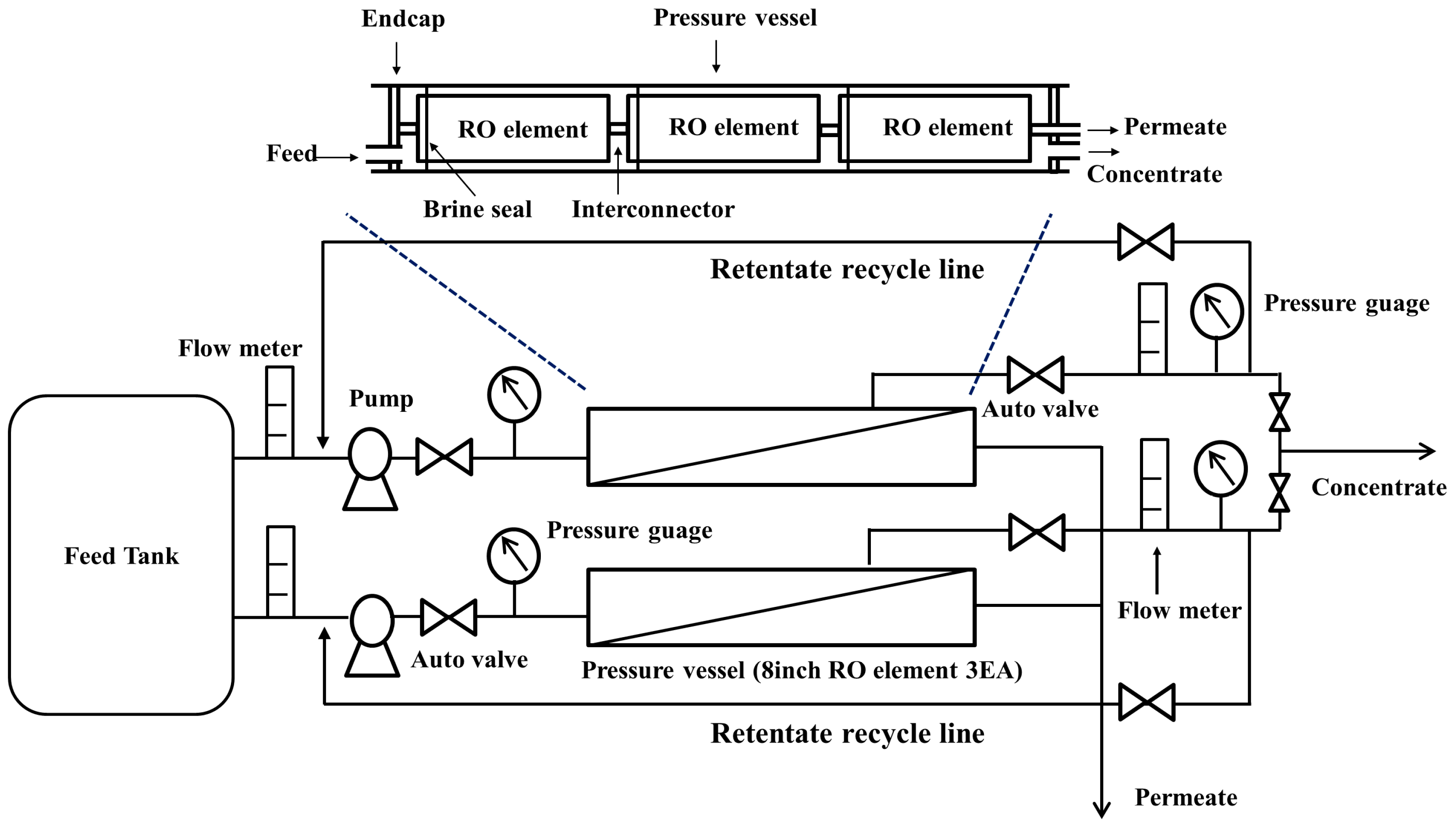
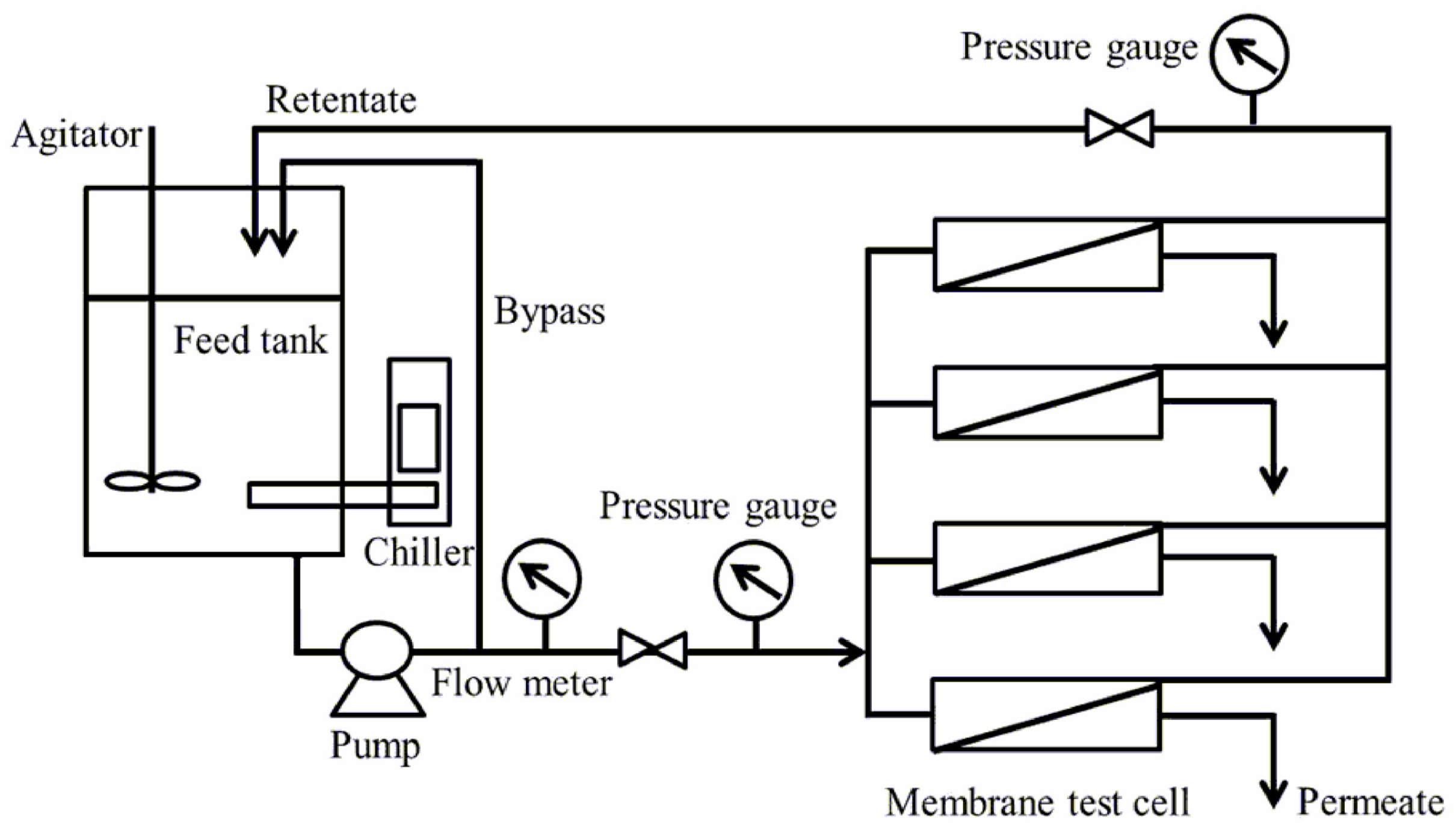
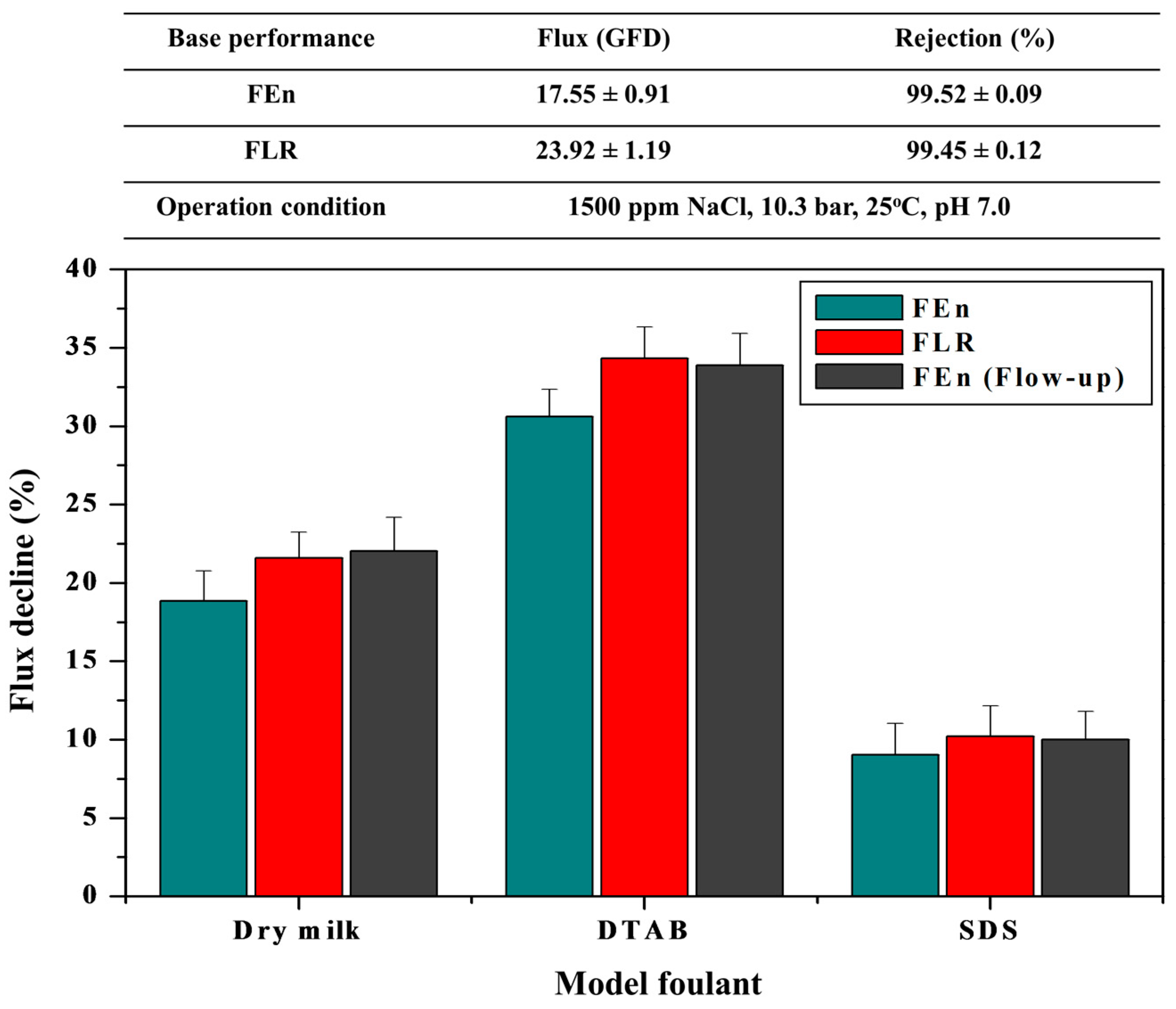
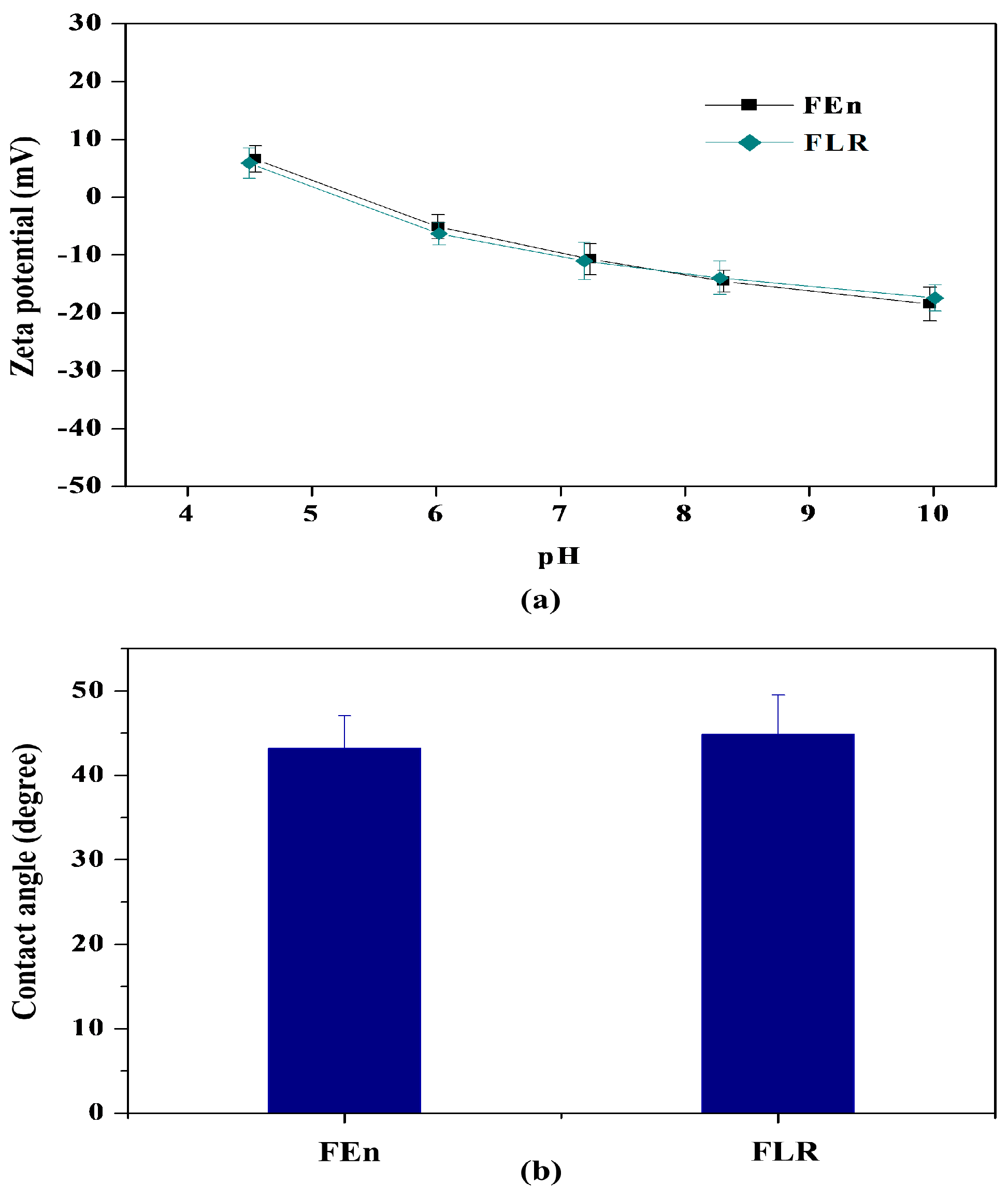
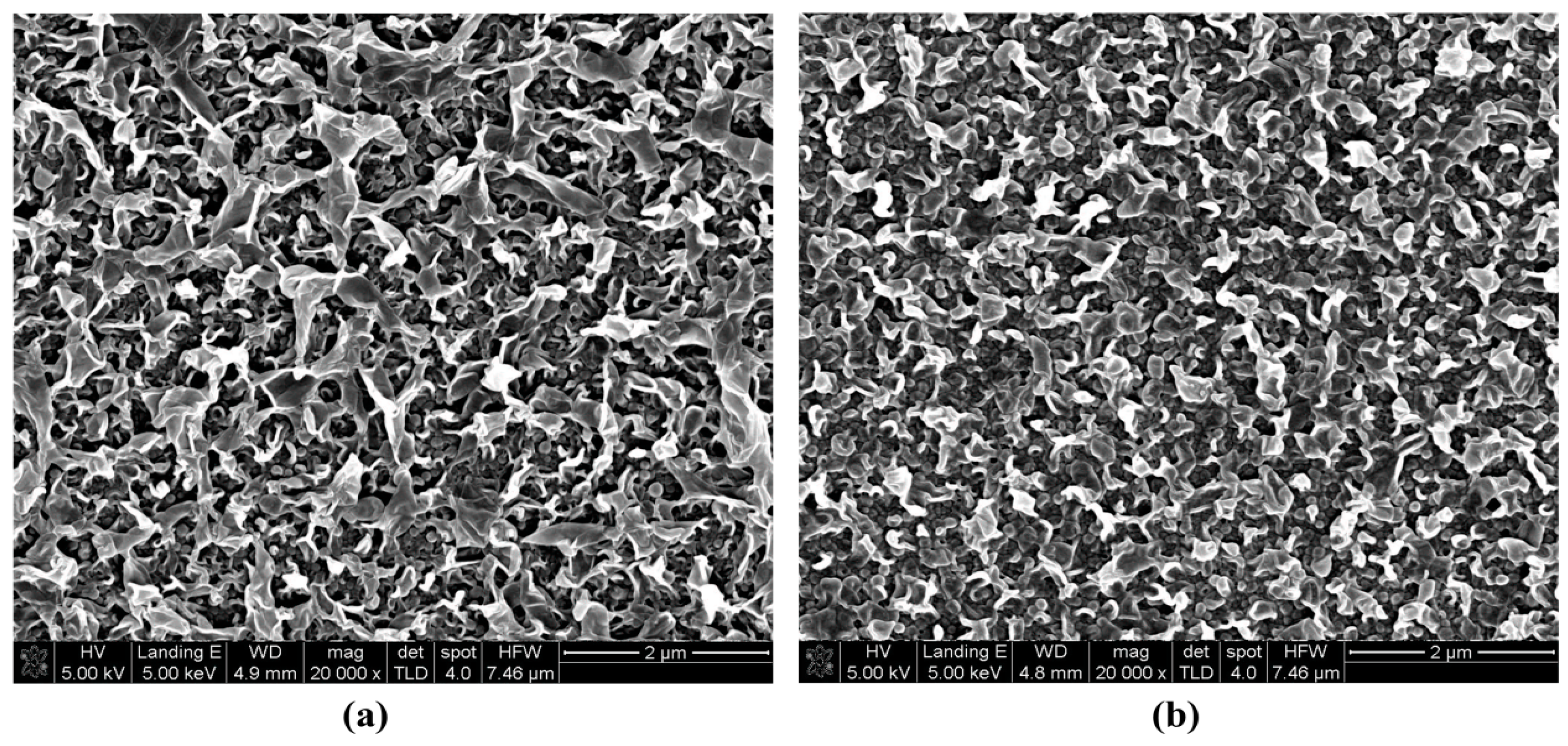
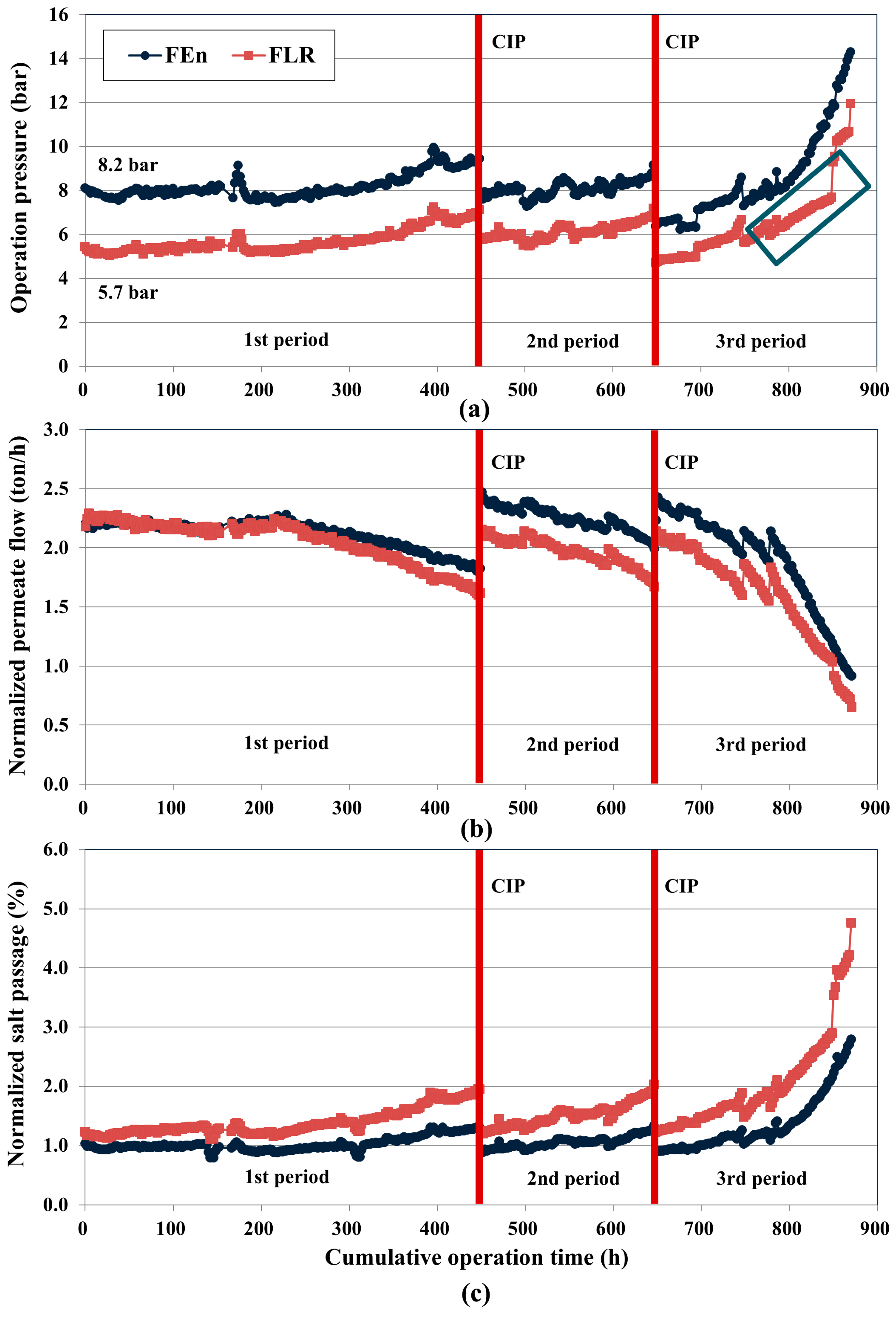
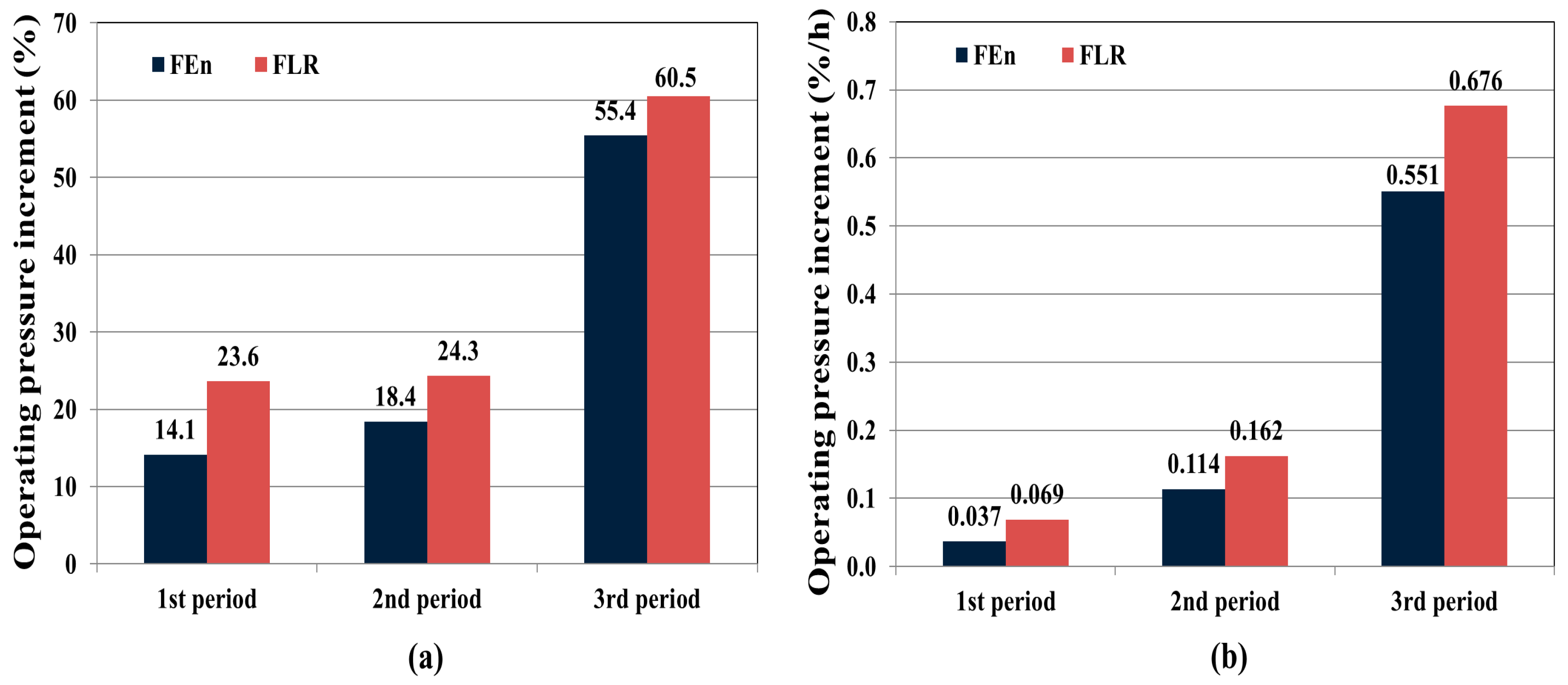
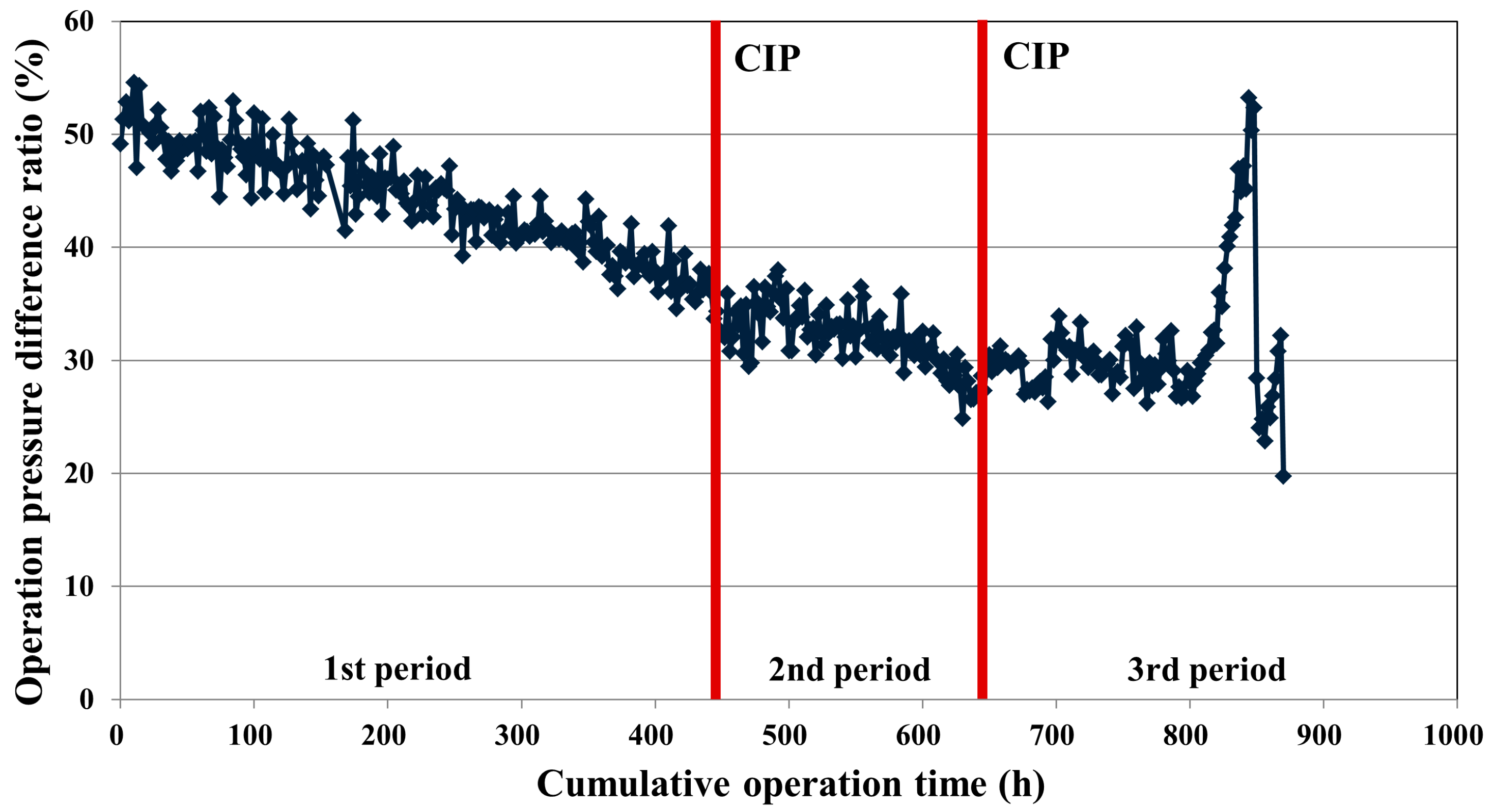

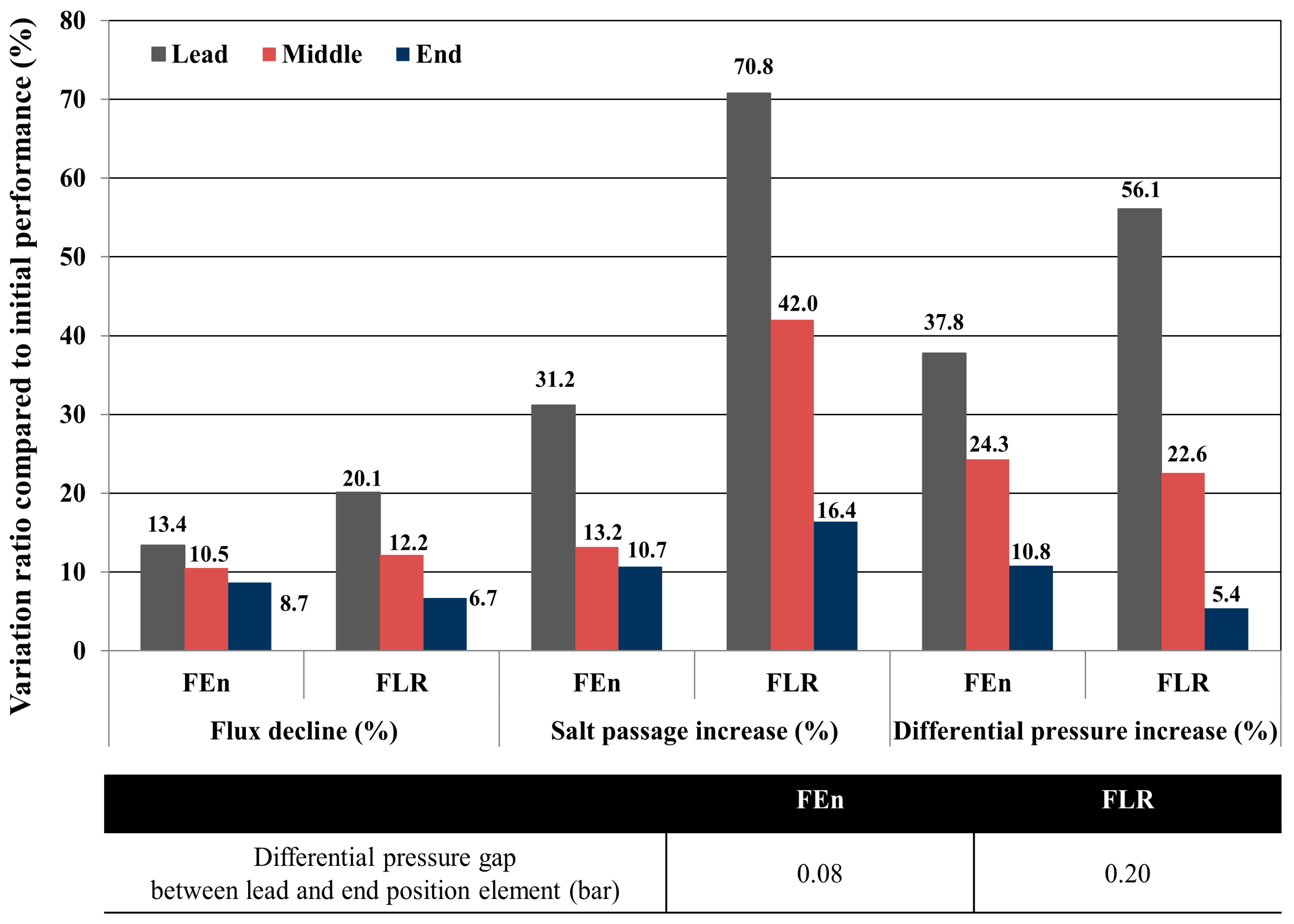
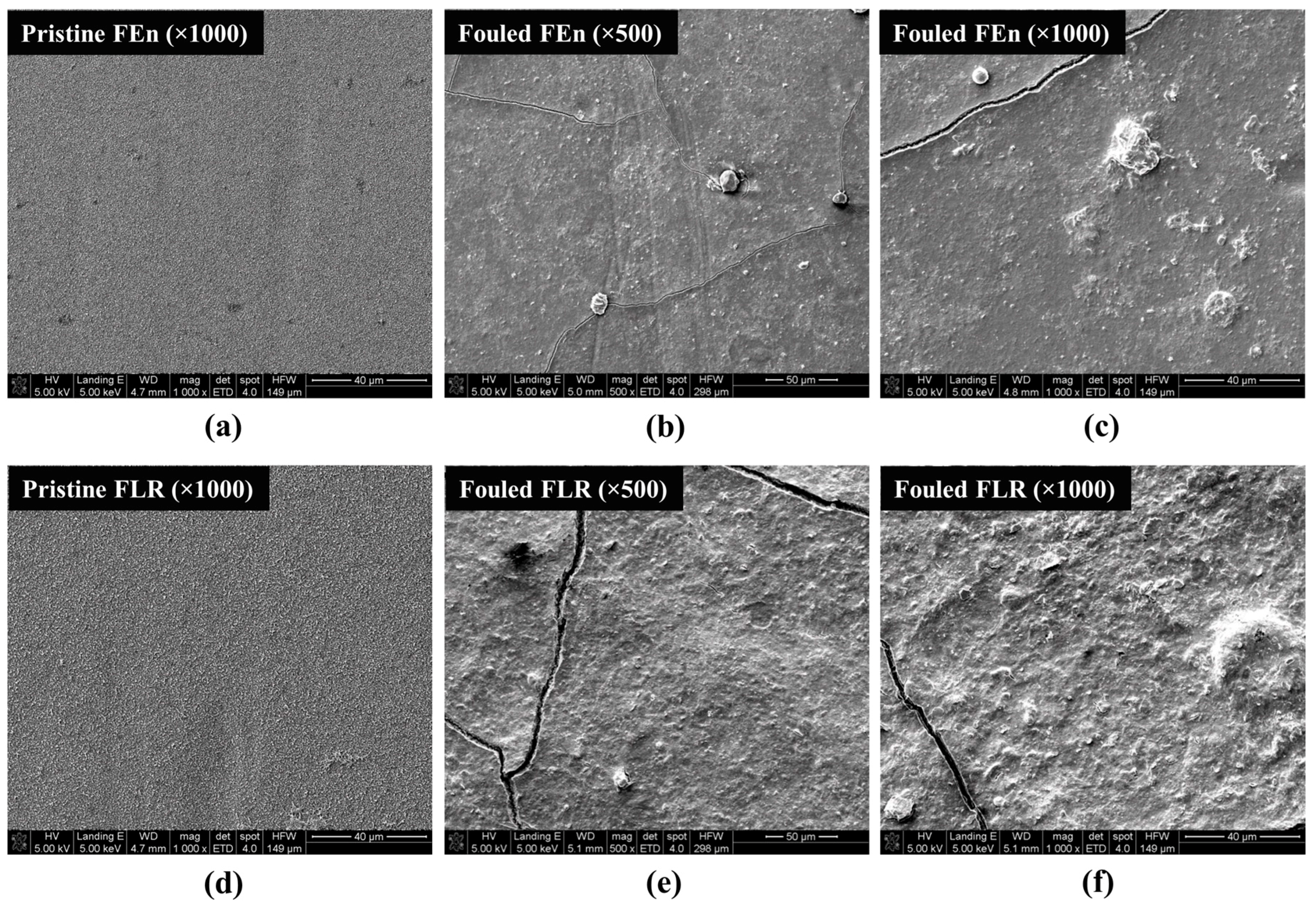


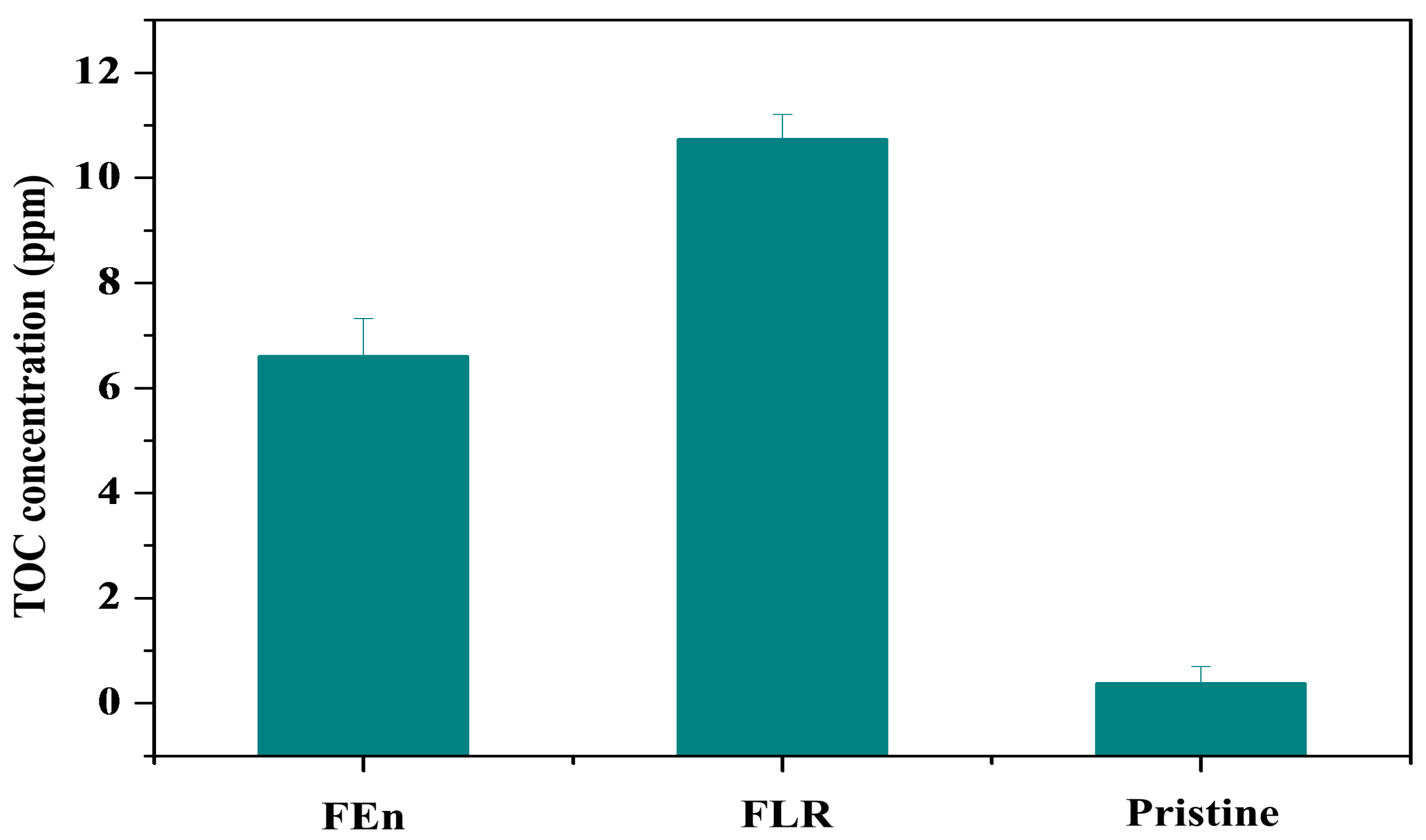
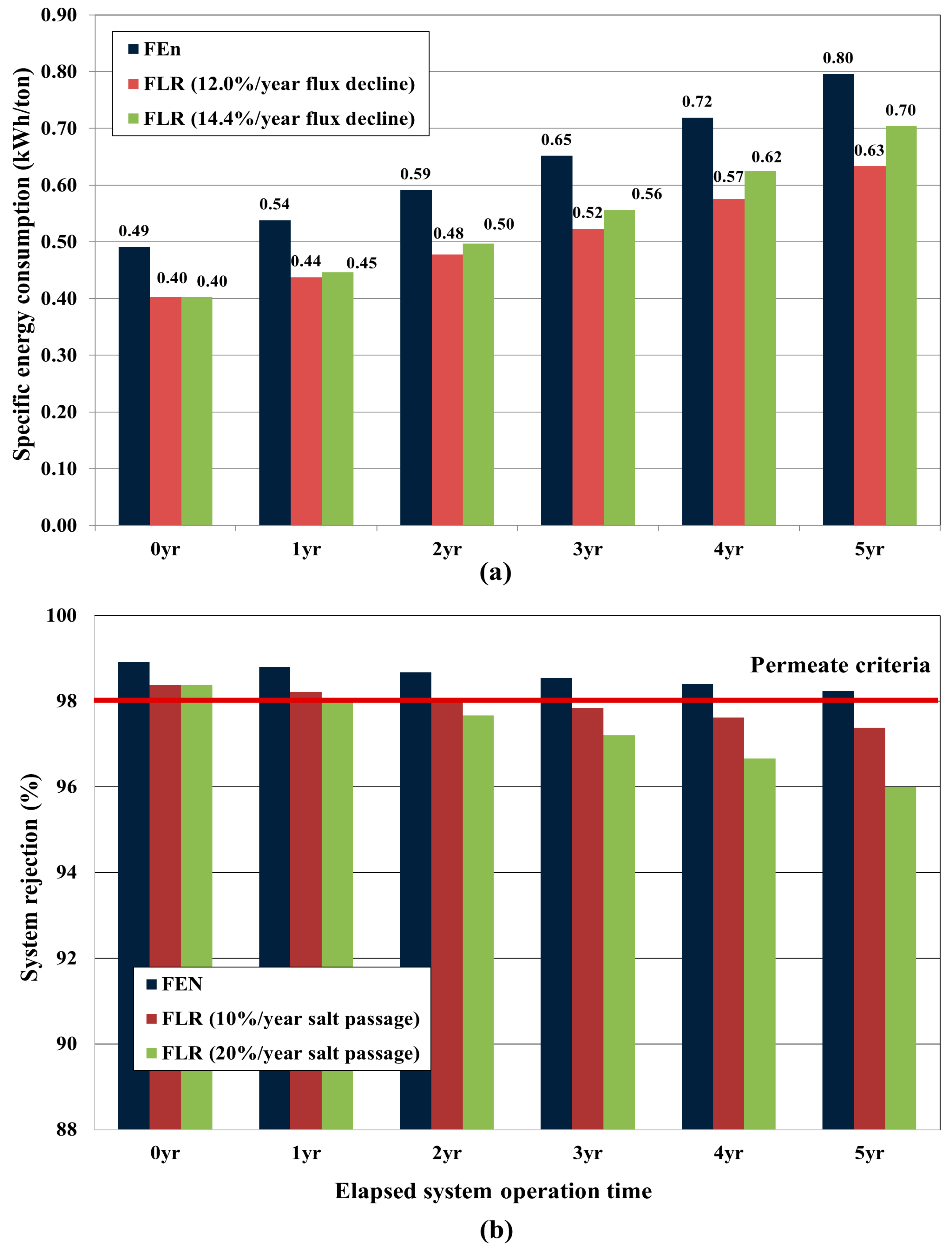
| RO Element Specification & Evaluation Parameters | ||
|---|---|---|
| Element specification | Pressure vessel A | RE8040-FLR (9000GPD/99.6%) a 3EA |
| Pressure vessel B | RE8040-FEn (10,500GPD/99.7%) b 3EA | |
| Operation conditions | Permeate (m3/h) | 2.2 m3/h (1 pressure vessel) |
| Recovery (%) | 33% | |
| Feed (m3/h) | 6.5 m3/h (1 pressure vessel) | |
| Monitoring parameters | Conductivity (μS/cm) | Feed, Permeate, Retentate |
| Pressure (bar) | Feed, Permeate, Retentate | |
| Feed water quality | Temperature, pH, SDI, Individual ion concentration, TDS | |
| Name | Type | Material | IR Absorbance Ratio (1540 cm−1/1588 cm−1) | Flux (gfd a) | Rejection (%) | Test Conditions |
|---|---|---|---|---|---|---|
| FEn | TFC b | Aromatic polyamide | 0.87 | 26.3 | 99.7 | 2000 ppm NaCl, 25 °C, 15.5 bar, pH 7 |
| FLR | 0.63 | 22.5 | 99.6 | 1500 ppm NaCl, 25 °C, 10.3 bar, pH 7 |
| Sample | Rp-v (nm) | Rms (nm) | Mean Height (nm) | Projected Area (μm2) |
|---|---|---|---|---|
| FEn | 585.8 | 69.93 | 249.3 | 25 |
| FLR | 568.2 | 63.39 | 176.1 | 25 |
| Operation Variables and Ion Species | Start~646 h | 646~872 h | Features | ||
|---|---|---|---|---|---|
| Operation Condition | Permeate (m3/h) | 2.2 m3/h | 2.2 m3/h | Retentate recycle (646 h~) | |
| Recovery (%) | 33% | 85% | |||
| Water Quality | Al | mg/L | 0.12 | 0.19 | |
| Si | mg/L | 2.3 | 2.9 | ||
| Mn | mg/L | N.D a | N.D a | ||
| B | mg/L | 0.06 | 0.11 | ||
| Ba | mg/L | N.D a | 0.05 | ||
| Sr | mg/L | N.D a | N.Da | ||
| Na+ | mg/L | 89.0 | 119.6 | ||
| K+ | mg/L | 12.0 | 13.8 | ||
| Mg2+ | mg/L | 12.0 | 14.5 | ||
| Ca2+ | mg/L | 72.1 | 94.7 | ||
| Cl− | mg/L | 107.3 | 140.2 | ||
| NO3− | mg/L | 19.7 | 23.6 | ||
| SO42− | mg/L | 145.6 | 193.0 | ||
| pH | - | 7.0 | 7.3 | ||
| Conductivity | μS/cm | 894.6 | 1141.7 | ||
| TOC | mg/L | 3.5 | 4.6 | ||
| SDI | - | 5.2 | 6.3 | ||
| Turbidity | NTU | 0.3 | 0.5 | ||
| CIP Procedure of Pilot RO System |
|---|
| 1. Preparing inorganic cleaning solution a: 1% cleaning chemical, pH 2.5, 35 °C |
| 2. Recycling for 1 h with inorganic cleaning solution at 2 bar, flow rate 6 m3/h |
| 3. Soaking for additional 16 h with inorganic cleaning solution and flush the system |
| 4. Preparing organic cleaning solution b: 1% cleaning chemical, pH 10.5, 35 °C |
| 5. Recycling for 1 h with organic cleaning solution at 2 bar, flow rate 6 m3/h |
| 6. Soaking for additional 1 h with organic cleaning solution |
| 7. Recycling for 1 h with organic cleaning solution at 2 bar, flow rate 6 m3/h |
| 8. Soaking for additional 1 h with organic cleaning solution |
| 9. Flush the system and then start the normal operation |
| Performance Monitoring Parameters | Sample | 1st Operation Period | 2nd Operation Period | 3rd Operation Period | Entire Test Period |
|---|---|---|---|---|---|
| Permeate flow variation rate (PVR, ton/h) a | FEn | −0.00086 | −0.00232 | −0.00583 | −0.00148 |
| FLR | −0.00125 | −0.00243 | −0.00657 | −0.00175 | |
| Salt passage variation rate (SVR, %/h) b | FEN | 0.00060 | 0.00220 | 0.00836 | 0.00201 |
| FLR | 0.00162 | 0.00418 | 0.01562 | 0.00405 |
| Design Parameter | Details |
|---|---|
| Designated product flow | 50,000 ton/day |
| Membrane type and model | Case 1: RE8040-FEn, Case 2: RE8040-FLR |
| Array configuration | 2 Array (270: 1st stage, 135: 2nd stage), 6 Elements/pressure vessel |
| Recovery ratio (%) | 75% |
| No. of pressure vessel (EA) | 405 |
| No. of element (EA) | 2430 |
| Average permeate flux (GFD) | 13.6 |
| Simulation Study Cases | Replacement Year | No. of Replaced Elements | Element Average Age after Partial Replacement |
|---|---|---|---|
| 20%/year annual salt passage increase case | 2nd year | 2025 EA (83.3%) | 1.2 year |
| 10%/year annual salt passage increase case | 3rd year | 1025 EA (50.0%) | 2 year |
© 2018 by the authors. Licensee MDPI, Basel, Switzerland. This article is an open access article distributed under the terms and conditions of the Creative Commons Attribution (CC BY) license (http://creativecommons.org/licenses/by/4.0/).
Share and Cite
Park, H.-G.; Kwon, Y.-N. Long-Term Stability of Low-Pressure Reverse Osmosis (RO) Membrane Operation—A Pilot Scale Study. Water 2018, 10, 93. https://doi.org/10.3390/w10020093
Park H-G, Kwon Y-N. Long-Term Stability of Low-Pressure Reverse Osmosis (RO) Membrane Operation—A Pilot Scale Study. Water. 2018; 10(2):93. https://doi.org/10.3390/w10020093
Chicago/Turabian StylePark, Hyung-Gyu, and Young-Nam Kwon. 2018. "Long-Term Stability of Low-Pressure Reverse Osmosis (RO) Membrane Operation—A Pilot Scale Study" Water 10, no. 2: 93. https://doi.org/10.3390/w10020093
APA StylePark, H.-G., & Kwon, Y.-N. (2018). Long-Term Stability of Low-Pressure Reverse Osmosis (RO) Membrane Operation—A Pilot Scale Study. Water, 10(2), 93. https://doi.org/10.3390/w10020093




